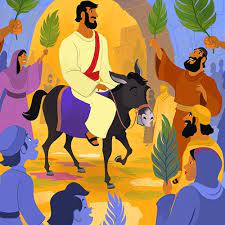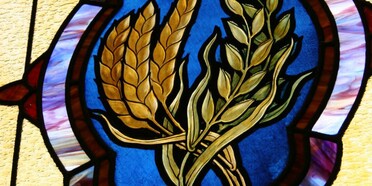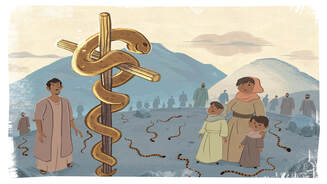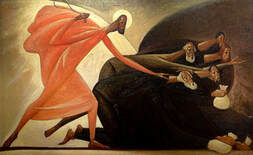
Mark 11:1-11 “
Today we enter the holiest and most significant time of our liturgical year – Holy Week. Over the next week we remember once more Jesus’ final journey to Jerusalem, where he was initially received with great fanfare and adulation, with waving palm branches, cloaks laid before him on the road like a red carpet, welcomed with cries of Hosanna! Throughout the week the tensions between Jesus and the religious leadership will reach a boiling point and Jesus’ fate will be sealed as his disciple Judas is bribed to betray him. This Thursday we observe Jesus final Passover meal with his disciples followed by his arrest at the Mount of Olives. Friday, our most somber holy day, recalls Jesus’ sentence to death, his torture, crucifixion and death as he takes on the sin of the world, our sin.
Then exactly a week from today we will stand with the disciples, stunned, fearful, amazed, rejoicing at the empty tomb and Christ’s victory over the grave. It’s a long emotional roller coaster of a journey, this next week. It’s a journey of deep valleys and high peaks. It is a procession that, if we allow it, will take us into every nook and cranny of our soul. It will force out every feeling. It will push us so we can identify with every act of faith, every cowardly act of fear, every act of meanness, every act of devotion, every tear, every shout of hosanna will be ours.
But let us not get ahead of ourselves. Let us pause and look at the context of Jesus’ grand entrance into Jerusalem. The crowd has been gathering. Jesus had just been teaching his disciples about what it went to be great in the kingdom of heaven – if we want to be great we need to be the slave of all. How not to hold back the little children from Jesus. How nothing is impossible with God. Jesus shares a third prediction of his death and resurrection. The scriptures tell us that Jesus had just left Jericho with this large crowd when Bartimaeus, a blind man keeps crying out, “Jesus, son of David, have mercy on me!” The crowd tries to silence him, but Bartimaeus persists. Jesus stops and calls him forward. Bartimaeus is so eager he throws his cloak down on the ground – he gives up everything to get to Jesus – and this blind man finds Jesus, and Jesus said, “what do you want me to do for you?” and Bartimaeus said “my teacher let me see again.” And Bartimaeus recovered his sight – immediately, it says, and he followed Jesus on the way.
You see, the triumphal entry into Jerusalem really began in Jericho, when blind Bartimaeus call out Jesus, Son of David! Bartimaeus, a poor blind man, pushed aside, told to be quiet, calls Jesus “Son of David,” son of the greatest king, the return of the mighty king so longed for by the people of Israel. This is the first time Jesus is called “Son of David” in Mark’s Gospel.
So Bartimaeus becomes the parade master of ceremonies. He was a blind man whose sight was restored - the last person healed before Jesus’ arrest according to Mark. Bartimaeus becomes the symbol of the faithful person, the symbol of the faithful person who will not be silenced by mob rule
Jesus, approaching Jerusalem, stops at Bethpage and Bethany, near the Mount of Olives. He is 1.5 miles away from the Holy City. We know the Garden of Gethsemane, where Jesus, prayed to be spared, where he was betrayed, arrested and abandoned, happen at the Mount of Olives. We know Bethany was the home of his dearest friends, Mary, Martha and Lazarus, whom he had recently raised from the dead.
Bethpage held great significance as well. Here is where the Sanhedrin, the leadership body of the Jewish people, sat as "elders sitting in the gate of the city." The main seat of the Sanhedrin was in the Temple but certain things could only be determined when they were at Bethpage, outside the walls of Jerusalem (Pesachim 63b). This was a very important place in the days of Jesus. Entering this way, he would be riding in through the Eastern Gate of Jerusalem proper. This is also the direction that the Jew's believe their Messiah will travel when he comes.
So, Jesus stops the procession and according in a very detailed manner, sends two disciples – to get a donkey. Other gospel writers place Bethpage as the village where the donkey was obtained. Isn’t it striking that Mark takes 7 out of 11 verses to describe this process? This must have been a very important point for Jesus. Jesus wanted to continue the final lap of the procession on a donkey. Not just any kind of donkey, but a colt, upon whom no one had ridden.
According to Old Testament guidelines, for an animal to be used for a sacred purpose, it must never have been used for any other purpose (Num. 19:2; Deut. 21:3. Jesus chose to fulfill a scripture that described a king as righteous, bringing salvation, and gentle – Jesus was careful not to convey an image of a messiah-king carrying a sword, riding a war horse, signaling destruction.
In this manner Jesus rides into the capital city as a King and is hailed by the people as such, in the manner of the day. The streets of Jerusalem, the royal city, are open to Him, and like a king, He ascends to His palace, not a temporal palace, but the spiritual palace, which is the temple, because His is a spiritual kingdom. He receives the worship and praise of the people -- Hosanna – Blessed is the one who comes in the name of the Lord! Blessed is the coming kingdom of our ancestor David! Jesus, knowing his hour had come, allows all this to unfold. The crowd takes over. We witness their acts of adulation. The waving of palms and laying down of coats by the people was no accident or coincidence. The Romans gave palms to the victors in the Roman games and emperors gave them to their subjects following their military conquests.
Then as meticulous as the procession began it quickly ends. Jesus enters Jerusalem: he goes to the Temple: he looks around at everything, and as it was late, he returns to Bethany with the twelve disciples. After all that trouble to get the donkey, we don’t know what Jesus did with it. But we do know that the donkey was a key player in the parade. It signals a messiah whose triumphal entry announces that kingship is service. In the kingdom of God the blind can see, the young and pure of heart are embraced, and no one is silenced.
Today we are almost invited to think back on that journey began from Nazareth to Bethlehem, as legend tells us, a donkey carrying Mary pregnant with Jesus. Even the lowly donkey played his part – so lowly it seems silly to mention. Today, Jesus sits upon another donkey that carries him to his rightful spiritual home in Jerusalem where a new birth is in order; where once more-- like his parents were turned away--- Jesus will be too.
Today Palm Sunday, we are invited to join the sacred procession of Holy Week: to be inspired by a faith of a blind man. To cast down whatever cloaks us. To find what we need that can carry us through this week. May our hearts be filled with the cries of Hosanna! Save us Lord! Have Mercy on us, Son of David!
Have a blessed and transformative holy week. Amen.



 RSS Feed
RSS Feed